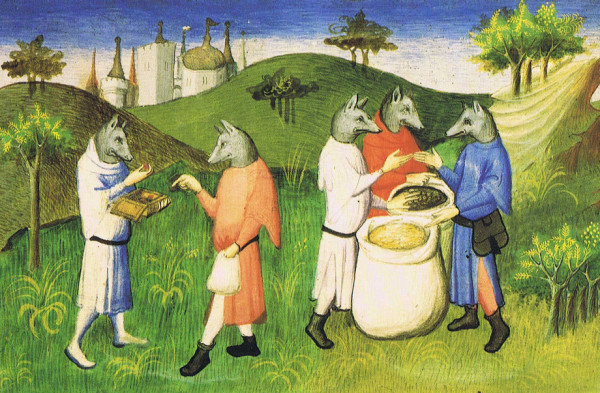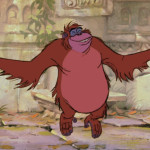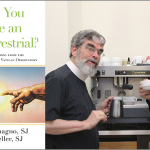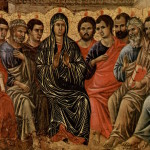St. Christopher, ET, and the Middle Ages
by Michael F. Flynn
Filed under Christianity and Science

It has long been held that the medievals would have been terrified of aliens, regarded them as "demons," and otherwise persecuted them in their religious ignorance and fanaticism, while we wise moderns would recognize them as intelligent and equivalent to humans, deserving of the same consideration as humans. The latter is a self-flattering mythos, but likely no more true than the former.
For illumination, we might turn to the well-known science-fiction novel, Eifelheim, but this too may be regarded as self-flattering. Besides, I have it on good authority that the author made it all up; so it can be seen as begging the question.
So let us turn to the story of Ratramus and the Dog-Heads (h/t James Hannam)
In his Encyclopedia, Pliny quotes from Megasthenes’ Indica regarding alien creatures living in India:
"Megasthenes writes that on different mountains in India there are tribes of men with dog shaped heads, armed with claws, clothed with skins, who speak not in the accents of human language, but only bark and have fierce grinning jaws.....Those who live near the source of the Ganges, requiring nothing in the shape of food, subsist on the odour of wild apples, and when they go on a long journey, they carry these with them for safety of their life by inhaling their perfume..Should they inhale air, death is inevitable."
The Dog-Heads were not the only aliens the medievals believed in. There were also the Monopods, the cyclops, the centaurs, men with eyes in their torsos, full hermaphrodite, and so on.
A Greek physician named Ctesias wrote:
"In the mountains dwell men who have the head of a dog; they wear skins of wild beasts as clothing, and they speak no language, but bark like dogs, and in this way understand one another’s speech. They have teeth bigger than a dog’s...they understand the speech of the Indians, but cannot respond to them; instead they bark and signal with their hands and fingers, as do mutes."
"All of them, men and women, have a tail above their hips, like a dog’s except bigger and smoother. They have intercourse with their wives on all fours like dogs, and consider any other form of intercourse to be shameful. They are just, and the longest lived of any human race; for they get to be 160, sometimes 200 years of age."
The existence of alien beings became popular in the medieval period. Sometimes they were used to frighten people (a la The Blob or Earth Versus the Flying Saucers) and sometimes they were used to illustrate virtues (ET: The Extraterrestrial) or vices (the Ferengi in Star Trek:The Next Generation). According to a Welsh poem, King Arthur fought with the creatures:
"On the mountain of Edinburgh; He fought with dog-heads; By the hundred they fell."
The story of St. Christopher from Ireland describes him thusly:
"Now this Christopher was one of the Dogheads, a race that had the heads of dogs and ate human flesh. He meditated much on God, but at that time he could speak only the language of the Dogheads. When he saw how much the Christians suffered he was indignant and left the city. He began to adore God and prayed. 'Almighty God,' he said, 'give me the gift of speech, open my mouth, and make plain thy might that those who persecute thy people may be converted.' An angel of God came to him and said: 'God has heard your prayer.' The angel raised Christopher from the ground, and struck and blew upon his mouth, and the grace of eloquence was given him as he had desired."
St Christopher was baptized and abjured his erstwhile human-eating. As a result he gained human appearance before getting martyred. Pay attention to that last: As a result of baptism, he "gained human appearance."
A 9th century churchman called Rimbert – later archbishop of Hamburg-Bremen – was planning to leave on a missionary journey to the northern reaches of Scandinavia. To prepare for his journey he wrote to Ratramnus, a monk of Corbie in Picardy, asking for information regarding the dog-heads, whom he thought he might encounter. According to a dossier Rimbert had put together, the dog-heads lived in villages, practiced agriculture, and domesticated animals. In response Ratramnus wrote his Epistola de Cynocephalis addressing the question of whether the dog-heads were "worthy of evangelism." The issue hinged on whether the mysterious creatures could be considered rational. (You may recall that in Eifelheim, Dietrich has a similar conversation with his old teacher Willi, a canon of Freiburg. If you don't recall this, that means you have not read the book, and you should rectify this error immediately and without hesitation.)
Ratramnus begins by describing the Dog-Heads' manner of speaking:
"...the form of their heads and their canine barking shows that they are similar not to humans but to animals. In fact, the heads of humans are on top and round in order for them to see the heavens, while those of dogs are long and drawn out in a snout so that they can look at the ground. And humans speak, while dogs bark."
And yet, "despite their appearance," Rimbert's information clearly depicts them as capable of domesticating animals:
"‘I do not see’ wrote Ratramnus, ‘how this could be so if they had an animal and not a rational soul’ since the living things of the earth were subjected to men by heaven, as we know from having read Genesis. But it has never been heard or believed that animals of one kind can by themselves take care of other animals, especially those of a domestic kind, keep them, compel them to submit to their rule, and follow regular routines."
Ratramnus pointed to the way in which the dog-heads ‘keep the rules of society’ and recognized the rule of law. ‘There cannot be any law, which common descent has not decreed. But such cannot be established or kept without the discipline of morality’. Unlike Ctesias’s dog-heads, Rimbert’s report stated that they covered their genitalia. Ratramnus interpreted this as a sign of decency and these and others attributes convinced him they were human; in any case, St Christopher had once been one and converted.
Hence, Ratramnus concluded that the dog-heads were degenerated descendants of Adam, although the Church generally classed them with beasts. They may even receive baptism by being rained upon.
Here Ratramnus was following in the footsteps of Augustine of Hippo, who had written that if the monstrous races do exist, they were created according to God’s will and, if they are human and descended from Adam, they must be capable of salvation. This would extend the Churches missionary obligation to the farthest flung parts of the earth and make ‘monstrous missionising’ a necessary fulfilment of Christ’s charge.
Before we chuckle too much at medieval beliefs, keep in mind that their cosmology impeded their ability to think of these aliens as living on other planets, where we sophisticated moderns imagine our own "dog-heads" to dwell. At least the medievals had "travelers' tales" to fall back on. They could reasonably believe that someone had been "out there" and brought back reports. And they never suffered from the defect of thinking that allowed moderns to seriously debate whether Africans or Amerinds had souls or even (when Darwinism informed the discourse) whether they were of the same species. When a medieval said that the Dog-Heads were "degenerated descendants of Adam," they had in mind that they were rational beings, not that they belonged to a biological species, although "common descent" is implicit in it.
Which brings us back to "St Christopher the Dog-Head." Why was it that no ones seemed to be any more outraged that a Dog-Head could be baptized and become a saint than that, say, a Krenk in Eifelheim could be so? The key is this: As a result of baptism, he gained human appearance. Church doctrine was that the soul was the substantive form of the human body. And the soul of a human was defined as a "rational soul," one possessing intellect [abstract reasoning] and will [appetite/desire for abstract concepts]. This is the "human form" or appearance, the "image" in which humans were said to have been made. Thus, while there was a clear distinction between humans and other animals, this was based on rationality. Any race of creatures which displayed rationality– as the Dog-Heads did in keeping a code of laws, showing dominion over other animals, etc.– would be regarded as the equivalent of human beings. In consequence, Church teaching has not changed in this regard, as Brother Guy Consolmagno, the Vatican astronomer, points out in this article: "Would You Baptize An Extraterrestrial?"
The Franciscan friar, John de Marignollis, travelled to the Far East in the 1330s and, in the spirit of true medieval empiricism, looked for "the monstrous races the ancients had spoken of." He asked the Indians about the existence of the dog-heads. They answered, "we thought they lived where you came from."
Alas, like today's aliens from other planets, the Dog-Heads always seem to live "somewhere else." I did not know the story of "St. Christopher the Dog-Head" or Ratramnus' reply to Rimbert when I wrote the original Eifelheim, lo these many years ago; but there is a certain uncanny similarity in the stories.
Related Posts
Note: Our goal is to cultivate serious and respectful dialogue. While it's OK to disagree—even encouraged!—any snarky, offensive, or off-topic comments will be deleted. Before commenting please read the Commenting Rules and Tips. If you're having trouble commenting, read the Commenting Instructions.












